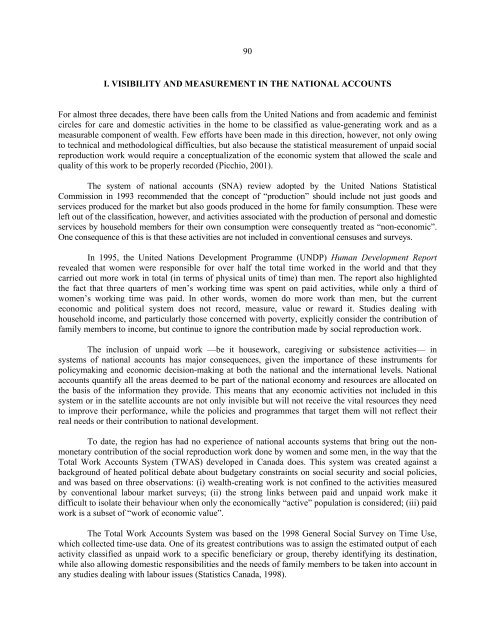Women in Latin America and the Caribbean - Cepal
Women in Latin America and the Caribbean - Cepal
Women in Latin America and the Caribbean - Cepal
Create successful ePaper yourself
Turn your PDF publications into a flip-book with our unique Google optimized e-Paper software.
90<br />
I. VISIBILITY AND MEASUREMENT IN THE NATIONAL ACCOUNTS<br />
For almost three decades, <strong>the</strong>re have been calls from <strong>the</strong> United Nations <strong>and</strong> from academic <strong>and</strong> fem<strong>in</strong>ist<br />
circles for care <strong>and</strong> domestic activities <strong>in</strong> <strong>the</strong> home to be classified as value-generat<strong>in</strong>g work <strong>and</strong> as a<br />
measurable component of wealth. Few efforts have been made <strong>in</strong> this direction, however, not only ow<strong>in</strong>g<br />
to technical <strong>and</strong> methodological difficulties, but also because <strong>the</strong> statistical measurement of unpaid social<br />
reproduction work would require a conceptualization of <strong>the</strong> economic system that allowed <strong>the</strong> scale <strong>and</strong><br />
quality of this work to be properly recorded (Picchio, 2001).<br />
The system of national accounts (SNA) review adopted by <strong>the</strong> United Nations Statistical<br />
Commission <strong>in</strong> 1993 recommended that <strong>the</strong> concept of “production” should <strong>in</strong>clude not just goods <strong>and</strong><br />
services produced for <strong>the</strong> market but also goods produced <strong>in</strong> <strong>the</strong> home for family consumption. These were<br />
left out of <strong>the</strong> classification, however, <strong>and</strong> activities associated with <strong>the</strong> production of personal <strong>and</strong> domestic<br />
services by household members for <strong>the</strong>ir own consumption were consequently treated as “non-economic”.<br />
One consequence of this is that <strong>the</strong>se activities are not <strong>in</strong>cluded <strong>in</strong> conventional censuses <strong>and</strong> surveys.<br />
In 1995, <strong>the</strong> United Nations Development Programme (UNDP) Human Development Report<br />
revealed that women were responsible for over half <strong>the</strong> total time worked <strong>in</strong> <strong>the</strong> world <strong>and</strong> that <strong>the</strong>y<br />
carried out more work <strong>in</strong> total (<strong>in</strong> terms of physical units of time) than men. The report also highlighted<br />
<strong>the</strong> fact that three quarters of men’s work<strong>in</strong>g time was spent on paid activities, while only a third of<br />
women’s work<strong>in</strong>g time was paid. In o<strong>the</strong>r words, women do more work than men, but <strong>the</strong> current<br />
economic <strong>and</strong> political system does not record, measure, value or reward it. Studies deal<strong>in</strong>g with<br />
household <strong>in</strong>come, <strong>and</strong> particularly those concerned with poverty, explicitly consider <strong>the</strong> contribution of<br />
family members to <strong>in</strong>come, but cont<strong>in</strong>ue to ignore <strong>the</strong> contribution made by social reproduction work.<br />
The <strong>in</strong>clusion of unpaid work —be it housework, caregiv<strong>in</strong>g or subsistence activities— <strong>in</strong><br />
systems of national accounts has major consequences, given <strong>the</strong> importance of <strong>the</strong>se <strong>in</strong>struments for<br />
policymak<strong>in</strong>g <strong>and</strong> economic decision-mak<strong>in</strong>g at both <strong>the</strong> national <strong>and</strong> <strong>the</strong> <strong>in</strong>ternational levels. National<br />
accounts quantify all <strong>the</strong> areas deemed to be part of <strong>the</strong> national economy <strong>and</strong> resources are allocated on<br />
<strong>the</strong> basis of <strong>the</strong> <strong>in</strong>formation <strong>the</strong>y provide. This means that any economic activities not <strong>in</strong>cluded <strong>in</strong> this<br />
system or <strong>in</strong> <strong>the</strong> satellite accounts are not only <strong>in</strong>visible but will not receive <strong>the</strong> vital resources <strong>the</strong>y need<br />
to improve <strong>the</strong>ir performance, while <strong>the</strong> policies <strong>and</strong> programmes that target <strong>the</strong>m will not reflect <strong>the</strong>ir<br />
real needs or <strong>the</strong>ir contribution to national development.<br />
To date, <strong>the</strong> region has had no experience of national accounts systems that br<strong>in</strong>g out <strong>the</strong> nonmonetary<br />
contribution of <strong>the</strong> social reproduction work done by women <strong>and</strong> some men, <strong>in</strong> <strong>the</strong> way that <strong>the</strong><br />
Total Work Accounts System (TWAS) developed <strong>in</strong> Canada does. This system was created aga<strong>in</strong>st a<br />
background of heated political debate about budgetary constra<strong>in</strong>ts on social security <strong>and</strong> social policies,<br />
<strong>and</strong> was based on three observations: (i) wealth-creat<strong>in</strong>g work is not conf<strong>in</strong>ed to <strong>the</strong> activities measured<br />
by conventional labour market surveys; (ii) <strong>the</strong> strong l<strong>in</strong>ks between paid <strong>and</strong> unpaid work make it<br />
difficult to isolate <strong>the</strong>ir behaviour when only <strong>the</strong> economically “active” population is considered; (iii) paid<br />
work is a subset of “work of economic value”.<br />
The Total Work Accounts System was based on <strong>the</strong> 1998 General Social Survey on Time Use,<br />
which collected time-use data. One of its greatest contributions was to assign <strong>the</strong> estimated output of each<br />
activity classified as unpaid work to a specific beneficiary or group, <strong>the</strong>reby identify<strong>in</strong>g its dest<strong>in</strong>ation,<br />
while also allow<strong>in</strong>g domestic responsibilities <strong>and</strong> <strong>the</strong> needs of family members to be taken <strong>in</strong>to account <strong>in</strong><br />
any studies deal<strong>in</strong>g with labour issues (Statistics Canada, 1998).











